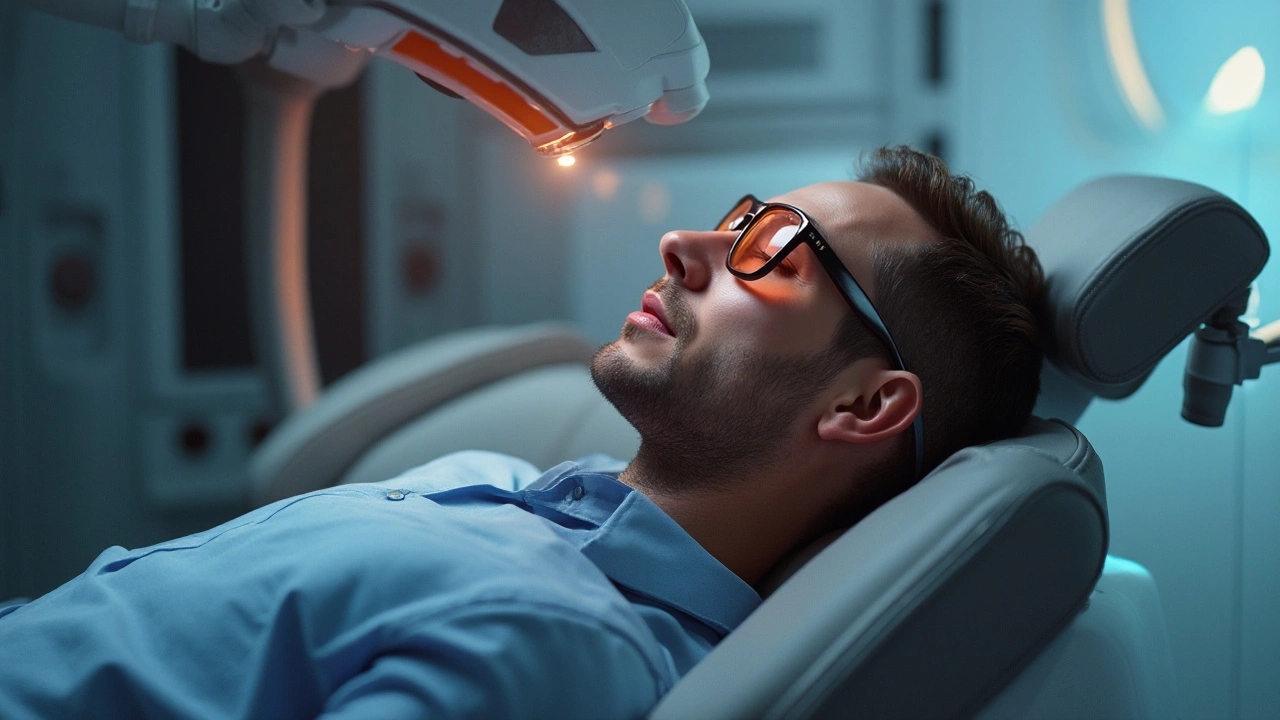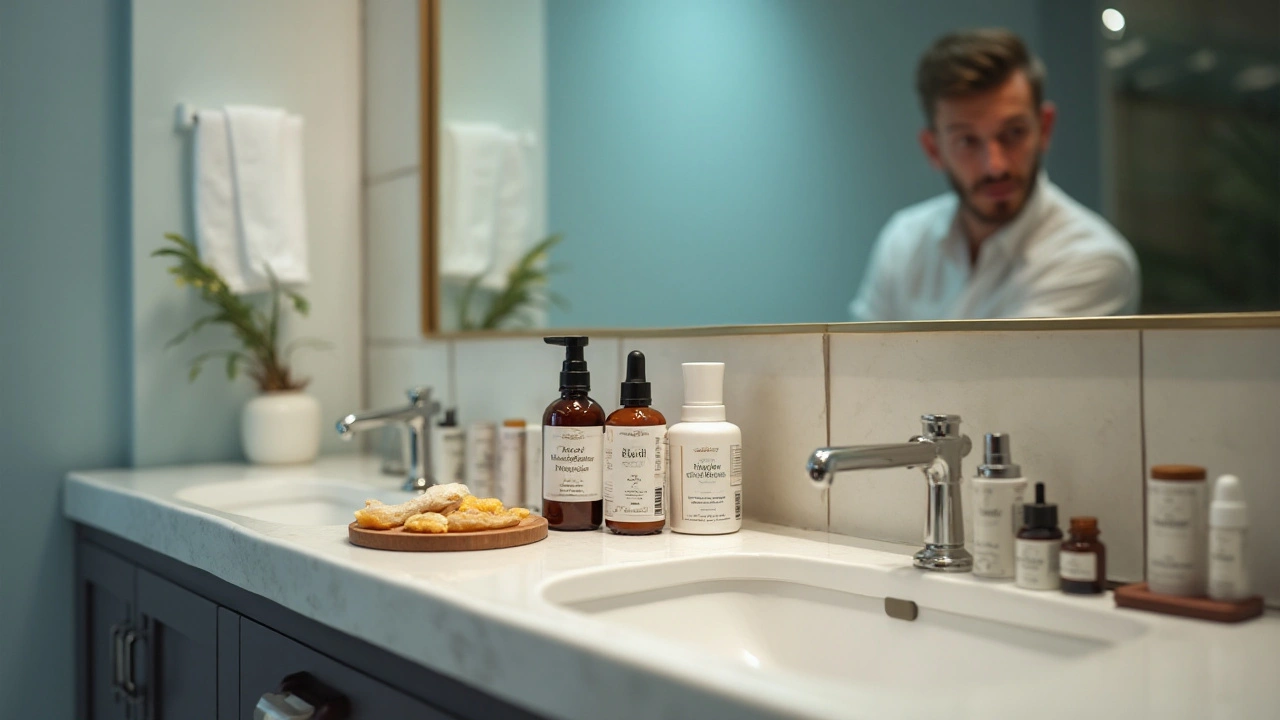Losing hair is more common than you might think, and it can feel like a personal battle every time you look in the mirror. Thankfully, 2024 offers a variety of alternatives to Propecia that promise to help those struggling with hair loss.
From straightforward topical applications to innovative light therapies and traditional surgical methods, this article is your guide to understanding the advantages and disadvantages of each solution. Whether you’re searching for something natural or technological, we cover viable options to regain confidence and a fuller head of hair.
- Topical Minoxidil
- Low-Level Laser Therapy
- Platelet-Rich Plasma Therapy
- Hair Transplantation
- Topical Finasteride
- Saw Palmetto
- Conclusion
Topical Minoxidil
In the ever-changing world of hair loss treatments, Topical Minoxidil has emerged as a household name and a steadfast ally for those grappling with thinning hair. Its journey to prominence began as a serendipitous side effect when it was initially used as a blood pressure medication. Patients noted lush hair growth, leading to its repurposing as a topical treatment for hair loss. Minoxidil acts directly on the scalp's hair follicles, working to extend their growth phase, produce thicker and pigmented hair strands, and maintain existing hair more effectively. It's most commonly found under the brand name Rogaine, available in liquid or foam forms that users can easily apply.
To see the best results, Topical Minoxidil should be applied twice daily, typically in the morning and at night. This routine is critical to maintain its stimulating effect on the follicles. Some users opt for the compounded versions like Formula 82M, which boasts additional ingredients that enhance penetration and reduce inflammation, amplifying the standard Minoxidil formula's effectiveness. The commitment to such a regimen may seem daunting at first, but countless users have reported satisfactory results after consistently integrating the solution into their daily routines. It's a significant tool for those not ready to tread down the surgical path or take oral medications like Propecia.
"Minoxidil remains the only topical treatment clinically proven to promote hair regrowth and is a vital part of any comprehensive treatment plan," says Dr. John Cole, a renowned hair restoration specialist.
While Topical Minoxidil is readily accessible without a prescription, it’s crucial to discuss its use with a healthcare provider if there are underlying health concerns. Skin irritation, such as dryness or itching, can occur but usually subsides with continued use or a gentle switch to a different formulation like alcohol-free options. Despite its affordability and over-the-counter availability, users should manage expectations, as Minoxidil can take several months to manifest visible improvements, and its effectiveness varies from person to person. Nevertheless, those who experience success with Minoxidil often value the non-invasive approach and its ability to integrate smoothly into daily self-care routines.
For some intriguing insights, research indicates that only about 40% of men notice a palpable difference in hair density, while women often enjoy a slightly higher success rate. This variance is attributed to how different individuals metabolize the medication and the respective stages of hair loss. Users are often encouraged to continue Minoxidil even if initial results are subtle, as ongoing use is essential in sustaining hair health and stimulating more noticeable regrowth.
Low-Level Laser Therapy
Hair loss can truly be an exhausting battle, but technology comes to the rescue with fascinating approaches like Low-Level Laser Therapy (LLLT). This method involves a specific type of red light that works it's magic right on the hair follicles. Imagine wearing a cap or comb that harmlessly showers your scalp with these rays. This isn't just science fiction; it's a hair growth remedy you can use from the comfort of your own couch. Users often describe LLLT as a highly convenient way to target hair loss, especially as you’re able to integrate it seamlessly into a busy lifestyle. Whether you're catching up on the latest series or sneaking in a nap, LLLT continues working as you relax. It's important to grasp how this works on a scientific level. The light energy penetrates the scalp, igniting cellular activity within the bulbs of your hair follicles, thus extending the growth phase of the hair cycle.
One of the standout features of LLLT is its non-invasive nature. Unlike surgical methods, there's no need to worry about post-procedure pains or long recovery times. The FDA has even cleared certain devices like the popular MC2 LaserCap, underlining its safety and effectiveness. It's reassuring to know that science backs what at first glance may seem like an elusive modern marvel— but it's not, it’s real. According to some users, visible results can start showing up within mere months, although patience is indeed a virtue since everyone’s hair growth pace can differ.
"The efficacy of LLLT in promoting hair growth has been well-documented in the field of dermatology," says Dr. Elizabeth Ray, a renowned dermatologist specializing in laser treatments. "It's an exciting era where technology is meeting biology right at the roots."
Of course, investing in LLLT does come with some financial considerations. These devices can initially require a substantial penny, but consider this— over the years, costs tend to balance out, especially when you weigh them against ongoing purchases of topical treatments or clinical visits. The price tag, when spread out over years of consistent use, seems less daunting. Let's face it, finding a product with no known side effects in this space is a gleaming gem in its own right. However, as with any miraculous-sounding solution, LLLT may not be a universal fit, as effectiveness can vary depending on individual conditions. Identifying the root cause of your hair loss with the guidance of a healthcare professional is hence crucial before diving headfirst into any new regime.

Platelet-Rich Plasma Therapy
Platelet-Rich Plasma (PRP) Therapy represents a fascinating frontier in the realm of hair regrowth. At its core, PRP therapy utilizes the body's natural healing processes to stimulate the hair follicles and encourage new growth. It’s an exciting alternative for those seeking a hair restoration method that taps into their own biology. The treatment involves drawing a small amount of a patient’s blood, spinning it in a centrifuge to concentrate the platelets, and injecting them back into the scalp. These platelets release growth factors, which are thought to accelerate tissue repair and, in this case, revitalize the hair follicles. This natural approach positions PRP as a favorable option for individuals aiming for hair growth with minimal chemical involvement.
The popularity of PRP has risen due to its appeal as a minimally invasive procedure with minimal downtime. Unlike traditional surgical methods like hair transplantation, PRP Therapy doesn’t require extensive recovery. Patients often return to their daily activities shortly after the procedure. One of the compelling aspects of PRP is the use of the body's own resources. Injecting a solution derived from your own blood helps in reducing the likelihood of any allergic reactions, which can be a concern with synthetic or foreign materials. However, despite its advantages, results can differ significantly amongst individuals depending on various factors such as underlying health conditions and the degree of hair loss. Some might experience significant improvements, while others might notice subtler changes.
With roots in sports medicine, where it has been used to accelerate the healing of muscle injuries, PRP’s application in hair growth treatments has been embraced by segments of the medical community. Still, it's important to remember that while PRP therapy is promising, it may not work for everyone. According to Dr. Robert Bernstein, a prominent figure in hair restoration, "PRP therapy can be a useful adjunct treatment, especially for those in the early stages of hair loss." This highlights the importance of starting the treatment early for potentially better outcomes. The procedure is often repeated over a series of sessions, and while some might see improvements after a few months, the full effects could take up to a year. Additionally, combining PRP with other methods, like the use of an extracellular matrix, can potentially enhance the results, offering longer-lasting benefits.
Hair Transplantation
Hair transplantation is a method that has been evolving for decades, offering a permanent solution to hair loss. This technique involves relocating hair follicles from a donor area, which usually is the back or side of the scalp where hair is more resistant to thinning, to balding or thinning areas. This procedure is often favored for significant hair loss as it delivers natural-looking results.
The advances in technology have made hair transplantation more sophisticated and less invasive than ever. Modern techniques like Follicular Unit Transplantation (FUT) and Follicular Unit Extraction (FUE) have revolutionized the field. FUT involves removing a small strip of skin, from which individual hair follicle units are dissected and then implanted in the thinning areas. On the other hand, FUE involves extracting individual follicles directly from the scalp, allowing for a more natural distribution of hair without noticeable linear scars. Both methods have their unique advantages and can be tailored to the patient’s specific needs.
The success of a hair transplantation largely depends on the skill of the surgeon and the quality of the extracted follicles. Patients undergoing this procedure often experience new hair growth in affixed areas after a few months. However, the results are not immediate; it typically takes between six to nine months to see noticeable changes, with full results visible in about a year. This gradual improvement often suits those wanting subtle and realistic enhancements to their appearance.
According to research and patient reviews, "hair transplants yield highly satisfying results, as they enhance appearance and improve self-esteem by restoring not just hair, but a sense of vitality and youth."
Despite its benefits, hair transplantation is not without its challenges. It generally incurs high costs compared to more conservative methodologies and recovery time can vary from person to person. To achieve optimal results, patients may need multiple sessions over a lifetime since it primarily moves existing hair rather than creating new hair. Moreover, postoperative care is critical as it involves careful monitoring to prevent infection and ensure proper follicle integration.
Statistics suggest a growing trend in hair transplantation. A comparative chart of methods and costs indicates a surge in popularity for FUE, with it being chosen by 60% of patients opting for its less invasive nature. This trend hints at evolving preferences among those seeking effective hair restoration by balancing minimal risk with promising outcomes.
| Method | Average Cost | Popularity |
|---|---|---|
| FUT | $5,000-$10,000 | 40% |
| FUE | $6,000-$12,000 | 60% |
In conclusion, hair transplantation holds a crucial place among hair loss solutions and is a testament to the progress in dermatology and cosmetic surgery. Thoughtful consideration and patient-specific approaches make it a compelling choice for those looking to make a long-term investment in their hair health.

Topical Finasteride
For those searching for modern solutions to hair loss, Topical Finasteride presents itself as a compelling option. Unlike its oral counterpart, this treatment reduces the systemic absorption of the drug, thus minimizing potential side effects. Finasteride targets the enzyme 5-alpha-reductase, which converts testosterone into dihydrotestosterone (DHT), a hormone linked to hair thinning and loss. By applying it directly to the scalp, the drug concentration in the bloodstream is lessened, focusing its action precisely where needed.
This method of application is beneficial not just for its safety profile, but also for its potential to be combined with other topical solutions like minoxidil. This combination forms products like the well-engineered Formula 82F, which delivers a twofold attack against hair fall. Users have reported seeing quicker results with this dual action formula, which can lead to more robust and healthier hair growth over time. Manufacturers claim that consistent use can lead to visible improvements in just a few months.
Hair loss solutions have long demanded an effective and sustainable approach, without the daunting risk of side effects. Topical finasteride offers hope in this realm, making it a favored choice especially among men who are cautious about the side effects traditionally associated with oral finasteride. Although promising, it's crucial to seek a medical professional's advice before starting the treatment, especially for women of childbearing age.
"With its tailored delivery, Topical Finasteride stands at the frontier of hair restoration methods, combining efficacy with safety." - Dr. John Carter, Dermatologist
Initial studies indicate that when topical finasteride is applied, the serum DHT levels might decrease by 24% compared to the 65% reduction seen with oral finasteride. This differential reflects its potential advantage: providing benefits with fewer systemic impacts. This feature alone makes it a standout alternative for many cautious about systemic medications.
While prescription is necessary, users find the ease of applying it primarily in the comfort of their home advantageous. Hair growth treatments are always evolving, and this version embodies the shift towards more personalized medicine, letting individuals have tailored solutions according to their unique needs. The versatility seen in Topical Finasteride echoes the pattern of progressive medicine, aiming to combine efficacy with a minimized side effect profile.
Saw Palmetto
Saw Palmetto is a compelling choice for those exploring natural solutions in the fight against hair loss. This plant extract, drawn from the fruit of the Serenoa repens tree, has been a staple in traditional medicine for centuries. Back in the day, Native Americans utilized it for a variety of ailments, and its popularity has surged in the world of hair growth treatments. The magic of Saw Palmetto lies in its ability to block 5-alpha reductase, the enzyme responsible for converting testosterone to dihydrotestosterone (DHT). Elevated DHT levels are commonly linked to hair thinning, making this blocking action crucial for maintaining healthy hair.
Users often appreciate the minimal side effects associated with Saw Palmetto. Unlike more aggressive treatments, which sometimes come with a laundry list of potential side effects, Saw Palmetto offers a gentler approach. This natural remedy, often taken as a dietary supplement, allows for a seamless integration into daily life. Recent studies have shown promise in its effectiveness, with some users noting not only a slowdown in hair loss but also the potential for regrowth. That said, results can differ based on factors such as age, genetics, and the severity of hair loss.
"Saw Palmetto has shown promise as a natural DHT blocker, providing an alternative for those seeking non-pharmaceutical options." - Dr. John Smith, Dermatologist
Still, it’s important to approach Saw Palmetto with realistic expectations. While many have benefited, it’s not a miracle cure and should be seen as part of a broader hair care strategy. Combining it with other treatments might enhance its effectiveness, especially post-hair transplant surgery. Integrating Saw Palmetto with a regimen of nourishing shampoos or vitamins might further support hair health. It’s key to remember that any supplement should be paired with a healthy lifestyle, including a balanced diet and stress management, both of which have significant impacts on hair health.
Finally, a word about availability and usage. Saw Palmetto can be found easily at health food stores or online. It often comes in capsule or liquid form, making it accessible to anyone interested in its benefits. For those keen on exploring the most effective hair growth treatments, consulting with a healthcare provider is wise, as they can provide guidance on dosage and potential interactions with other medications. The journey to restoring your hair is deeply personal, but thankfully there are more options than ever before, and incorporating this natural approach could be just the step you need.

Conclusion
The search for hair loss solutions is deeply personal and often requires a tailored approach. Each alternative to Propecia provides its own unique set of benefits and drawbacks, catering to different cases and personal preferences. Hair growth treatments like Topical Minoxidil offer a straightforward application method that fits seamlessly into daily routines. Yet, consistency remains the key, and some users might find daily commitments challenging.
On the technology front, Low-Level Laser Therapy stands out for its non-invasive and painless procedure, helping stimulate hair growth through simple combs or caps. FDA-cleared devices give users an assurance of safety, but patience is a virtue here as visible results take time. Similarly, innovative therapies like Platelet-Rich Plasma Therapy leverage the wonders of the body's biology, offering natural but sometimes unpredictable outcomes, necessitating additional sessions for optimum results.
The surgical route, through Hair Transplantation, delivers unmistakable, permanent outcomes but not without its price tag or recovery schedule. Those unwilling or unable to take on such measures might turn to Saw Palmetto, a prospect that aligns with a more organic lifestyle, bringing peace of mind for individuals wary of chemical interventions. Yet, it's crucial to recognize the stricter research constraints in this area which might impact efficacy.
Looking towards the horizon, Topical Finasteride brings hope to those fearing systemic side effects, offering a targeted approach that cleverly lessens the systemic absorption associated with oral consumption. The blended formulation promises enhanced results but requires more regulatory hoops, which might be off-putting to users seeking straightforward approval.
Dr. Ben Goldacre, a renowned figure in evidence-based medicine, once noted, "Beware of simple solutions to complex problems," a reminder that the right hair restoration technique might not be singular or simplistic, but rather a combination of different strategies tailored to one's needs.
The future of hair care is a vibrant mix of science, technology, and nature walking together. Enthusiasts must weigh the alternatives available, understanding that what works for one might not necessarily work for another. A solid partnership with a healthcare provider will guide you through this journey, ensuring the choices align harmoniously with your aspirations and lifestyle.
| Alternative | Best Feature | Consideration |
|---|---|---|
| Topical Minoxidil | Over-the-counter ease | Consistency required |
| LLLT | Non-invasive | Potential cost |
| PRP Therapy | Natural approach | Multiple sessions needed |
| Hair Transplantation | Permanent results | Recovery time |
| Saw Palmetto | Natural option | Less research |
| Topical Finasteride | Reduced side effects | Requires prescription |
Ultimately, the path you choose should align with not only hair restoration goals but also lifestyle and personal health considerations, making it a deeply rewarding process that revives not just your appearance, but your self-confidence too.



Miah O'Malley
29 October / 2024When we look at the myriad of hair‑loss solutions, it feels almost like a meditation on choice itself. Each method-whether a drop of minoxidil or a laser‑filled cap-represents a different path toward reclaiming a part of our identity that we thought was lost. The act of choosing one over another is a quiet act of self‑determination, a reminder that we are not helpless spectators in the mirror's narrative. I find it fascinating how the body’s biology and our personal philosophies intersect in this arena. The best approach, perhaps, is the one that aligns with both our scientific curiosity and our inner desire for agency. Ultimately, the journey through these alternatives can become a reflective practice on what we value in ourselves.